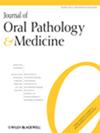Erythroblast transformation-specific-related gene promotes metastasis of oral squamous cell carcinoma by transcriptionally upregulating peroxiredoxin 1
Abstract
Background
Some studies confirmed that erythroblast transformation-specific-related gene (ERG) may be a pathogenic factor of oral squamous cell carcinoma (OSCC). However, the undergoing molecular mechanism has not been elucidated yet.
Objective
In this study, the investigation will focus on how the transcription factor ERG modulates the biological behaviors of OSCC.
Methods
In this study, cancer tissue specimens and corresponding paracancer tissues were collected from 54 patients. Real-time polymerase chain reaction analysis and Western blots were employed to detect the expression of multiple genes. Cell proliferation assays, Transwell, and flow cytometry assay were utilized to detect the proliferation, invasion, and apoptosis of OSCC cell, respectively. Dual luciferase reporter gene and chromatin immunoprecipitation assays were conducted to verify the regulation of ERG on PRDX1.
Results
ERG exhibits high expression levels in OSCC. Inhibition of ERG has been shown to effectively suppress the malignant growth of OSCC cells. Moreover, ERG has been found to transcriptionally upregulate the expression of PRDX1. The knockdown of PRDX1 has demonstrated its ability to inhibit the malignant growth of OSCC cells. Interestingly, when PRDX1 is overexpressed, it attenuates the inhibitory effect of si-ERG on the malignant growth of OSCC cells. This suggests that PRDX1 may play a crucial role in mediating the impact of ERG on malignancy in OSCC cells.
Conclusion
The transcription factor ERG promotes the expression of PRDX1, which could enhance the proliferation and invasion while inhibiting the apoptosis of OSCC cells.

 求助内容:
求助内容: 应助结果提醒方式:
应助结果提醒方式:


